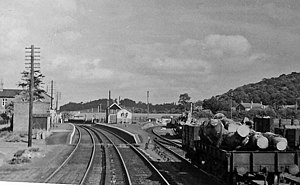Abermule train collision

Abermule station in 1953, looking north-east towards Welshpool. There are few changes since 1921. The station buildings are on the up platform to the left, the signal box on the down platform to the right.
|
|
| Date | 26 January 1921 |
|---|---|
| Time | 12:06 |
| Location | Abermule, Montgomeryshire |
| Country | Wales |
| Rail line | Cambrian Line |
| Cause | Single-line token error |
| Statistics | |
| Trains | 2 |
| Deaths | 17 |
| Injuries | 36 |
| List of UK rail accidents by year | |
The Abermule train collision was a head-on collision which occurred at Abermule, Montgomeryshire, Wales on 26 January 1921, killing 17 people. The crash arose from misunderstandings between staff which effectively over-rode the safe operation of the Electric Train Tablet system protecting the single line. A train departed carrying the wrong tablet for the section it was entering and collided with a train coming the other way.
The Cambrian Railways, which traversed Wales from Whitchurch in Shropshire to Aberystwyth and Barmouth, via Dovey Junction, contained a number of single line sections. The small station of Abermule was a crossing station between two such sections. To the east was Montgomery, to the west was Newtown.
To protect the single line sections, Tyer's Electric Train Tablet apparatus was used. Two linked tablet instruments were used on each section, one at each end. To allow a train to proceed into the section, a call button would be pressed on one instrument, alerting the operator at the other end of the section. If the other operator was in a position to accept the train, he would then press a release button on his instrument, which allowed a tablet (a metal plate inscribed with the name of the section) to be withdrawn from the caller's instrument. The tablet would then be placed inside a pouch fitted with a metal loop (which allowed it to be easily picked up or handed over by a train crew while in motion) and given to the driver of the train as proof of his authority to occupy the section. Until the tablet was replaced in one of the instruments, another tablet could not be withdrawn from either of them. Tablets of adjacent sections had differently-shaped and -positioned holes and notches in them to prevent a tablet being inserted into wrong instrument.
...
Wikipedia
